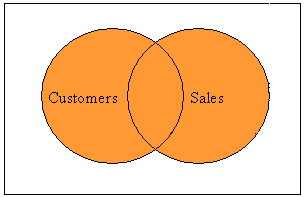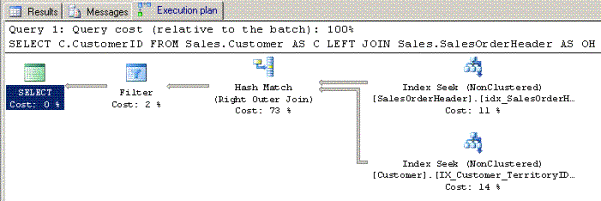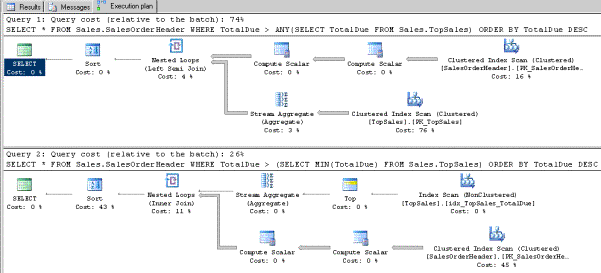I was reviewing the Microsoft training courses for SQL2008 for a set of application developers who wanted to learn more about SQL Server. In doing so I came across some commands that I either had not heard of or had not used before.
- INTERSECT
- EXCEPT
- ALL
- ANY
ALL and ANY have been around for donkeys years but INTERSECT and EXCEPT were new to me.
Whenever I find a new set of commands in T-SQL I fire up my developer edition and go straight to Adventureworks to start playing around.
INTERSECT, EXCEPT and UNION
To experiment with these commands I decided to look at two sets of CustomerID values
- Customers in sales territory 10 (United Kingdom)
- Sales orders in July 2004, the last month of orders in Adventureworks
Perhaps the best way to show what these commands do when comparing two sets of data is to look at the diagrams below
| Predicate | Illustration | Description |
|---|---|---|
| EXCEPT |  | Customers from the UK who have not bought in the last month (July 2004) |
| INTERSECT |  | Customers from the UK AND who have made a purchase in the last month (July 2004) |
| UNION |  | Customers from the UK OR who have made a purchase in the last month (July 2004) |
Different ways of writing an EXCEPT query
Although I had not used the EXCEPT before I had achieved the same ends by more traditional methods. As any DBA will know there are many ways of achieving exactly the same thing so I will illustrate 3 solutions.
LEFT JOIN
The following query yielded the results I needed
SELECT C.CustomerID
FROM Sales.Customer AS C
LEFT JOIN Sales.SalesOrderHeader AS OH
ON C.CustomerID = OH.CustomerID
AND OrderDate>='2004-07-01'
WHERE OH.CustomerID IS NULL
AND C.TerritoryID=10

Table 'Worktable'. Scan count 0, logical reads 0, physical reads 0, read-ahead reads 0, lob logical reads 0, lob physical reads 0, lob read-ahead reads 0.
Table 'Customer'. Scan count 1, logical reads 7, physical reads 0, read-ahead reads 0, lob logical reads 0, lob physical reads 0, lob read-ahead reads 0.
Table 'SalesOrderHeader'. Scan count 1, logical reads 5, physical reads 0, read-ahead reads 0, lob logical reads 0, lob physical reads 0, lob read-ahead reads 0.
SQL Server Execution Times:
CPU time = 15 ms, elapsed time = 196 ms.
The overall query cost was 0.0517279
WHERE CustomerID NOT IN(…)
Being a diligent DBA I wanted to try the query a different way
SELECT CustomerID
FROM Sales.Customer
WHERE TerritoryID=10
AND CustomerID NOT IN(
SELECT customerid
FROM Sales.SalesOrderHeader
WHERE OrderDate>='2004-07-01'
)

Table 'Worktable'. Scan count 0, logical reads 0, physical reads 0, read-ahead reads 0, lob logical reads 0, lob physical reads 0, lob read-ahead reads 0. Table 'Customer'. Scan count 1, logical reads 7, physical reads 0, read-ahead reads 0, lob logical reads 0, lob physical reads 0, lob read-ahead reads 0. Table 'SalesOrderHeader'. Scan count 1, logical reads 5, physical reads 0, read-ahead reads 0, lob logical reads 0, lob physical reads 0, lob read-ahead reads 0. SQL Server Execution Times: CPU time = 16 ms, elapsed time = 160 ms.
This time the overall query cost was 0.0500904 offering a slight improvement.
EXCEPT
Finally I tried the EXCEPT predicate
SELECT CustomerID
FROM Sales.Customer
WHERE TerritoryID=10
EXCEPT
SELECT customerid
FROM Sales.SalesOrderHeader
WHERE OrderDate>='2004-07-01'

Table 'Worktable'. Scan count 0, logical reads 0, physical reads 0, read-ahead reads 0, lob logical reads 0, lob physical reads 0, lob read-ahead reads 0.
Table 'Customer'. Scan count 1, logical reads 7, physical reads 0, read-ahead reads 0, lob logical reads 0, lob physical reads 0, lob read-ahead reads 0.
Table 'SalesOrderHeader'. Scan count 1, logical reads 5, physical reads 0, read-ahead reads 0, lob logical reads 0, lob physical reads 0, lob read-ahead reads 0.
SQL Server Execution Times:
CPU time = 15 ms, elapsed time = 202 ms.
The time for the EXCEPT predicate was 0.0500904. Exactly the same as for the WHERE NOT IN(…) query. You can also see that the execution plans are the same.
Different ways of writing an INTERSECT query
I decided to take the same approach with the INTERSECT query and write the equivalentquery in 3 separate ways.
INNER JOIN
As any customer can have more than one order I am going to have to make a distinct list of CustomerID values. I decided to try a couple of approaches.
SELECT DISTINCT C.CustomerID
FROM Sales.Customer AS C
INNER JOIN Sales.SalesOrderHeader AS OH
ON C.CustomerID = OH.CustomerID
WHERE
C.TerritoryID=10
AND OH.OrderDate>='2004-07-01'
SELECT C.CustomerID
FROM Sales.Customer AS C
INNER JOIN (SELECT DISTINCT CustomerID FROM Sales.SalesOrderHeader WHERE OrderDate>='2004-07-01'
)AS OH
ON C.CustomerID = OH.CustomerID
WHERE C.TerritoryID=10
This produced two differing execution plans with an overall cost of 0.0500859 and 0.0513978 respectively.

WHERE CustomerID IN(…)
This time the query below yielded an execution cost of 0.0499945
SELECT CustomerID
FROM Sales.Customer
WHERE TerritoryID=10
AND CustomerID IN(
SELECT customerid
FROM Sales.SalesOrderHeader
WHERE OrderDate>='2004-07-01'
)

INTERSECT
Finally, as before the INTERSECT query presented an identical execution plan to the WHERE CustomerID IN ( query
SELECT CustomerID
FROM Sales.Customer
WHERE TerritoryID=10
INTERSECT
SELECT customerid
FROM Sales.SalesOrderHeader
WHERE OrderDate>='2004-07-01'
Conclusion for INTERSECT and EXCEPT
Granted Adventureworks is a pretty contrived example and under such conditions the example I have given here INTERSECT and EXCEPT are as good as the best of the rest.
|
| |||||||||||||||||||||||
At this stage I cannot think of a compelling reason to use these new predicates over and above the more usual WHERE field NOT IN (…) particularly as the query on both sides of an EXCEPT or INTERSECT has to return the same recordset structure.
I did consider using it as a means of deduplicating two address record sets but that would be an even more contrived example.
The test does emphasize that it is worthwhile trying to write the query more than one way in order to determine the best option for the particular scenario.
The ANY and ALL Predicate
ANY and ALL are predicates I have never needed to use.
ANY
The two queries below offer up the same results and execution plan
SELECT *
FROM Sales.SalesPerson
WHERE TerritoryID = ANY(
SELECT TerritoryID FROM Sales.SalesTerritory WHERE CountryRegionCode='US'
)
SELECT *
FROM Sales.SalesPerson
WHERE TerritoryID IN(
SELECT TerritoryID FROM Sales.SalesTerritory WHERE CountryRegionCode='US'
)
To look at how ANY may be used in a more practical sense I decided to create a Sales.TopSales table in Adventureworks using the query below
SELECT TOP 5 SalesOrderID,TotalDue
INTO Sales.TopSales
FROM Sales.SalesOrderHeader
ORDER BY Sales.TotalDue DESC
ALTER TABLE Sales.TopSales
ADD CONSTRAINT PK_TopSales PRIMARY KEY CLUSTERED( SalesOrderID)
CREATE INDEX idx_TopSales_TotalDue ON Sales.TopSales(TotalDue DESC)
For my example I decided to retrieve sales that exceeded the minimum in my Sales.TopSales table.
SELECT *
FROM Sales.SalesOrderHeader
WHERE TotalDue > ANY(SELECT TotalDue FROM Sales.TopSales)
ORDER BY Sales.TotalDue DESC
An alternative way of writing this query could be as follows
SELECT *
FROM Sales.SalesOrderHeader
WHERE TotalDue > (SELECT MIN(TotalDue) FROM Sales.TopSales)
ORDER BY Sales.TotalDue DESC
The execution plans show considerable differences
- ANY query cost = 3.47092
- Alternative query cost = 1.24152

ALL
The ALL predicate allows a comparison to be made against all the values in a SELECT list. The following two queries are identical
SELECT *
FROM Sales.SalesOrderHeader
WHERE TotalDue > ALL(SELECT TotalDue FROM Sales.TopSales)
ORDER BY Sales.TotalDue DESC
SELECT *
FROM Sales.SalesOrderHeader
WHERE TotalDue > (SELECT MAX(TotalDue) FROM Sales.TopSales)
ORDER BY Sales.TotalDue DESC
Once again the execution plans tell the full story
- ALL query cost 3.47068
- Alternative query cost 1.24152

Conclusion for ALL and ANY
ALL and ANY certainly date back to SQL Server 7.0 and possibly before that. I have never found a reason to use them and given my findings I see no benefit to them.
Both predicates insist that their contents are produced from SELECT statements so where an IN predicate can contain a static list or a SELECT statement, ANY can only contain a SELECT statement.
The best I could results I could achieve for the ANY predicate simply equaled those for the more flexible IN predicate.
Rounding it all up
ALL and ANY do not seem to offer any benefits to offset their disadvantages
INTERSECT and EXCEPT do at least offer seem to offer performance on par with alternatives but so far I cannot see a benefit to using them. They are however part of the ANSI standard SQL.



